Abstract
This contribution focuses on electroconductive elastomeric composites based on styrene–butadiene rubber filled with graphite, conductive carbon blacks, and a mixture of these fillers to investigate changes in their conductivity during cyclic deformation. Static conductivity, mechanical properties, and conductivity with simultaneous recording of the stress-strain curve were measured to characterize the composites. The composites containing higher amounts of graphite showed an increase in maximum stress and a decrease in conductivity dependency starting from the second cycle. The results show the potential to design and construct flexible conducting composites based on styrene–butadiene rubber in broad applications such as in the automotive industry.
1. Introduction
During the last decade, various efforts have been directed towards the construction of several types of sensors such as plane heaters [1], pH sensors [2], chemical sensors [3], and electrochemical sensors [4]. In this regard, the investigation of changes in electrical conductivity during deformation seems to be of particular interest, especially in the case of an electroconductive composite consisting of an insulating elastomeric matrix and conductive filler. In particular, elastomeric conductive composites have attracted a great deal of attention due to their low cost, light weight, and easy processing, which allow them to be used in many engineering applications such as electromagnetic interference shielding (EMI), conductors, and sensors in vehicle design [5]. The selection of a polymer matrix with favorable stretchability and excellent processability is a crucial factor for strain sensing. From this point of view, styrene–butadiene rubber (SBR) is an excellent stretchable material compared to other rubbers [6]. Commonly, conductive fillers are carbonaceous fillers, e.g., carbon black (CB), graphite (Gr), or metallic powders [7,8]. However, the relationship between the mechanical stresses and changes in the electrical conductivity of materials during practical applications must be understood in detail to get reproducible results.
Basically, a sudden increase in the conductivity of these composites takes place in a relatively narrow range of filler content, starting at the so-called percolation threshold [9,10]. At the percolation threshold, the filler particles form an electroconductive physical network through the matrix, enabling the easy and fast transport of electrons through the conductive pathways.
The conductivity of rubber−filler composites is sensitive to several factors such as the filler’s conductivity, the amount of conductive filler in the rubber, the filler’s structure, and the specific surface area [11]. However, the conductive pathways can also be affected by many external parameters such as mechanical deformation, which leads to modification of the structure or even to the destruction of the filler’s network structure. However, to the best of our knowledge, the effect of the mixture of CB and graphite on the electrical conductivity of SBR composites under mechanical tension has not been investigated yet.
In this contribution, we are comparing elastomeric conductive composites based on SBR filled with Gr, highly conductive CB, and a mixture of these fillers to determine the changes in the conductivity of rubber composites under cyclic mechanical deformation. The online measurement of conductivity and recording of the cyclic stress–strain curve is the most important aspect of this contribution.
2. Materials and Methods
2.1. Materials
Poly (styrene-co-butadiene) rubber (SBR, SKS 30, KAUČUK Kralupy a.s., Kralupy nad Vltavou, Czech Republic), carbon black (Vulcan®, N-234, Cabot Corp., Lešná, Czech Republic), and graphite (EG-10, synthetic graphite, SGL Carbon, Birmingham, UK) were used as rubber and conducting fillers. A sulfur vulcanizing system containing N-cyclohexyl-2-benzothiazole sulfenamide CBS (Duslo, Šal’a, Slovakia), stearic acid (Setuza, Ústí nad Labem, Czech Republic), zinc oxide (Slovlak, Košeca, Slovakia), and sulfur (Siarkopol, Tarnobrzeg, Poland) were provided.
2.2. Preparation of Rubber Composites
The rubber compounds based on 100 phr (part per hundred rubber) of SBR matrix consisted of 3 phr ZnO, 1 phr stearic acid, 1 phr Sulfenax CBS, and 1.75 phr of sulfur. Composites were prepared by mixing raw materials in a 50 mL mixing chamber of a Plastograph PLE 331 (Brabender, Duisburg, Germany). Rubber, fillers in the amounts of 10, 20, 30, 40, 50, 60, and 65 phr graphite (Gr) and 50 phr carbon black (CB), and additives (without sulfur or accelerator) were mixed at 100 °C for 10 min at 40 rpm. In the second step, sulfur and accelerator were added to the compound at 90 °C for 8 min at 25 rpm. Afterward, the rubber compounds were calendered through a laboratory two roll-mill (Nishimura, Tokyo, Japan) under ambient conditions to increase their homogeneity via sheeting, rolling, and sheeting steps. This procedure was repeated four times with a rolling space of 5 mm and four times with a rolling space of 2 mm and was finally followed by two sheeting steps with a rolling space of 0.5 mm.
Testing specimens were compression-molded using a press machine (Fontijne TP 50, Delft, The Netherlands) at 150 °C for an optimal vulcanization time of 30 min. In order to measure the electrical current, two copper wires were inserted into the rubber composite during compression. The specimens (100 × 10 × 0.7 mm3) were compression-molded using a custom mold.
2.3. Mechanical Properties
Tensile testing was performed using a universal testing machine (Instron 3365, Instron, Norwood, MA, USA). The rate of deformation was 10 mm·min−1. The electrical current and the stress–strain curve were recorded in parallel. An elongation speed of 10 mm·min−1 and voltage 10 V were used. Consequently, the stress-release steps were repeated up to seven times.
2.4. Dynamic Mechanical Thermal Analysis (DMTA)
DMTA measurements of the rubber composites were performed using a DMA Q800 (TA Instruments, Hüllhorst, Germany). Samples with dimensions of 10 × 7 × 1 mm3 were measured in tensile mode at a frequency of 10 Hz, an amplitude of 20 µm, and a heating rate of 2 °C/min in the temperature range of −70 °C to 100 °C.
2.5. Broadband Dielectric Spectroscopy
Broadband dielectric spectroscopy was carried out using an Alpha dielectric spectrometer provided by Novocontrol Technologies GmbH (Montabaur, Germany). Disk-shaped samples with a 20 mm diameter and a ~0.5 mm thickness were used. The frequency range of 0.1 Hz–1 MHz was used to measure the samples at room temperature. The test cell for samples was the BDS-1200 parallel-plate capacitor (Novocontrol Technologies, Montabaur, Germany) containing two gold-plated electrodes.
2.6. Online Measurements of Conductivity During Cyclic Deformation
The electrical current was measured during five cycles of mechanical deformation up to an elongation of 100% using a wireless TRMS multimeter (EXTECH Instruments, Shanghai, China). Figure 1 illustrates the setup for the measurement of conductivity changes under cyclic deformation. The voltage and the rate of deformation were set to 30 V and 10 mm·min−1, respectively.
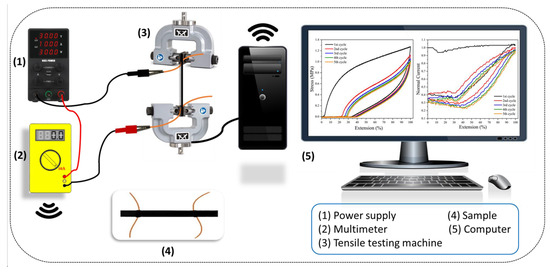
Figure 1.
Online setup for monitoring the conductivity changes under cyclic deformation [7].
3. Results and Discussion
3.1. Determination of Percolation Threshold
Broadband dielectric spectroscopy is used as a sensitive technique to determine the percolation threshold of composites, a characteristic associated with the formation of physical conductive filler networks. The electrical conductivities of SBR-Gr and SBR-CB composites as a function of filler content are shown in Figure 2. A sudden increase in the conductivity was observed when a concentration of the filler reached the so-called percolation threshold. Theoretically, at this concentration, an infinite cluster of particles is formed in the polymeric matrix. Figure 2 shows that the composites containing CB have an obviously lower percolation threshold in comparison with the SBR-Gr composites. Compared to the other conductive fillers, CB particles have a higher tendency to form conductive networks, which is attributed to their ability to form chain-like aggregates [7].
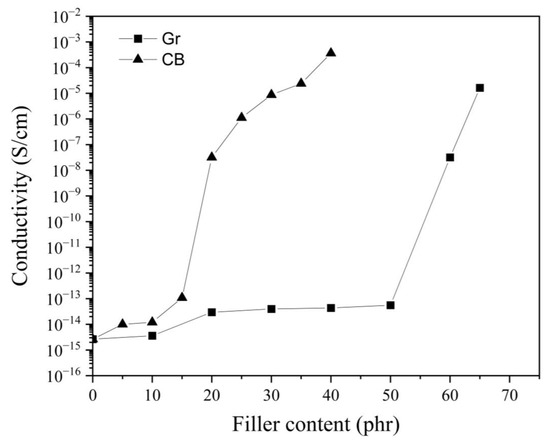
Figure 2.
Electrical conductivity as a function of filler content (phr—part per hundred rubber) of composites filled with graphite (Gr) and carbon black (CB).
It is known that percolation depends neither on the filler size nor on its distribution. In other words, if an amorphous matrix is used, this concentration depends strongly on the filler shape [12]. Basically, the filler can be dispersed only in the amorphous phase of the semi-crystalline matrix. Therefore, in the case of a highly crystalline matrix, smaller fillers can agglomerate more easily than bigger ones due to their higher specific surface area. Additionally, the electrical conductivity versus the frequency of the composites filled with Gr and Gr-CB are shown in Figure 3. The samples containing 55, 60, and 65 wt% Gr were not used for conductivity measurement during deformation since the samples were broken before they reached 100% strain. Therefore, SBR-based composites were prepared from the combination of constant 50 phr CB and five different Gr concentrations.
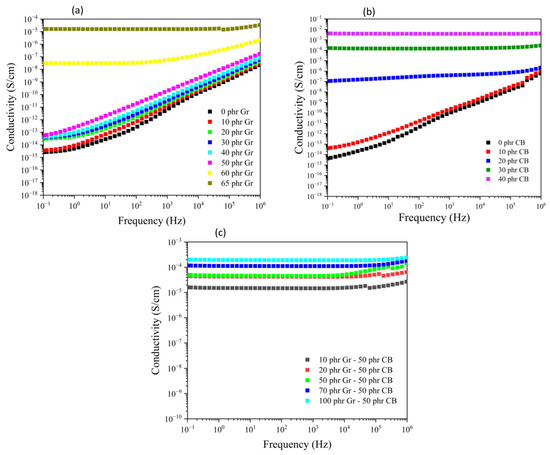
Figure 3.
The electrical conductivity as a function of frequency for the SBR composites filled with (a) graphite (Gr), (b) carbon black (CB), and (c) Gr—CB mixture.
3.2. Conductivity Behavior During Cyclic Deformation
Stress−strain behavior and the typical dependency of conductivity on applied cyclic mechanical deformation are shown in Figure 4. As can be seen, there is a significant difference between the first cycle and the others, with the following dependencies being almost identical for the rest of the cycles. Stress−strain cycles showed a standard shape with typical features of hysteresis. The stress is substantially higher before maximum deformation is reached compared to the values measured during the decrease in deformation. The composite containing a higher amount of Gr exhibited an increase in maximum stress, which is associated with the existence of more rigid physical network. Furthermore, the conductivity shows a decrease caused by the defects in the conductive pathways that result from a relatively small mechanical deformation. The conductivity decrease is higher at a lower Gr concentration, which corresponds to a lower number of conductive pathways in the composite.
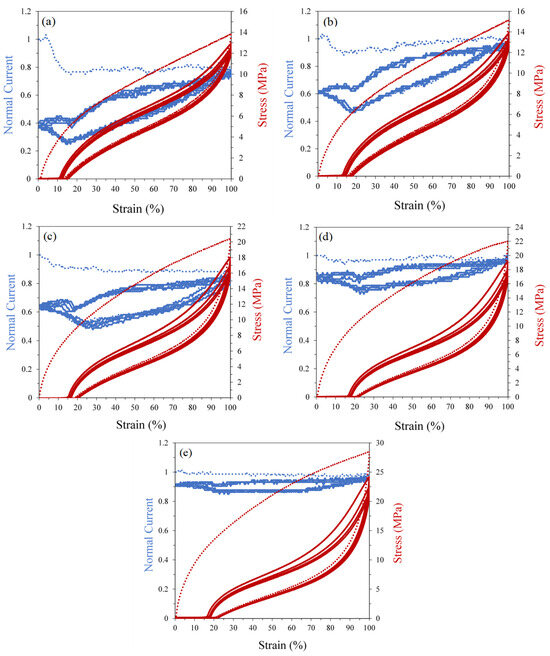
Figure 4.
Stress−strain curves and the typical dependence of conductivity on applied cyclic mechanical deformation—first cycle (dashed lines): constant 50 phr carbon black (CB) with (a) 10 phr, (b) 20 phr, (c) 50 phr, (d) 70 phr, and (e) 100 phr graphite (Gr).
It is worth noting that the conductivity dependency, starting from the second cycle, decreased with increasing Gr content. This phenomenon can be ascribed to the existence of the rigid physical network, and infinite clusters can be created after an agglomeration of Gr and CB particles.
3.3. Dynamic Mechanical Thermal Analysis (DMTA)
DMTA analysis was carried out to determine the viscoelastic behavior of the vulcanizates related to molecular motion and structural changes. Tan δ curves of the rubber composites are presented in Figure 5. With the increase in the Gr amount and total filler content, Tg moves to higher temperatures. It is an indication of an increase in rigidity and lower molecular mobility caused by filler−polymer interaction [13,14].
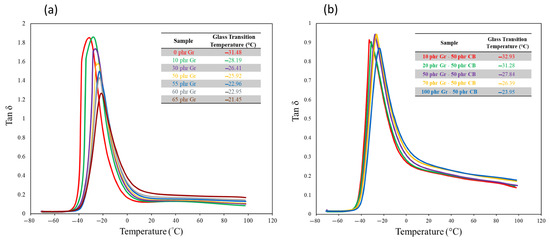
Figure 5.
Tan δ curves for the rubber composites filled with (a) graphite (Gr) and (b) graphite—carbon black (CB) mixture.
In the other words, filling the SBR matrix with rigid particles results in a stiffer material due to the reinforcement effect of the CB and Gr particles. This observation was also supported by the conductivity behavior of the rubber composite during cyclic deformation, as well as by the increase in maximum stress in each cycle.
4. Conclusions
This work provides novel insight into conductive elastomeric composites based on SBR filled with highly conductive CB, Gr, and a mixture of these fillers. The effect of fillers on the conductivity behavior of these composites was evaluated. The composites filled with CB showed obviously lower percolation thresholds in comparison with the SBR−Gr composites. In measurements of electrical conductivity during cyclic deformation, a decrease in conductivity was observed due to the destruction of the conductive pathways by a relatively small mechanical deformation. The conductivity decrease is higher at lower Gr concentrations. However, the conductivity dependency, starting from the second cycle, decreased with increasing Gr content. The composites demonstrated an increase in Tg with an increase in the Gr amount, which is associated with higher rigidity and lower molecular mobility of the rubber matrix.
Author Contributions
Conceptualization, H.P. and I.C.; writing—original draft, H.P.; methodology, H.P. and Z.Š.; software, H.P. and Z.Š.; investigation, H.P.; writing—review and editing, H.P., Z.Š. and I.C.; supervision, I.C.; funding acquisition, H.P. All authors have read and agreed to the published version of the manuscript.
Funding
This research was funded by the Slovak Grant Agency VEGA 2/0109/23 and project COST HISTRATE CA21155.
Institutional Review Board Statement
Not applicable.
Informed Consent Statement
Not applicable.
Data Availability Statement
The original contributions presented in the study are included in the article, further inquiries can be directed to the corresponding author.
Conflicts of Interest
The authors declare no conflicts of interest.
References
- Kimura, T.; Asano, Y.; Yasuda, S. Self-temperature-control plane heaters by polyethylene glycol-graphite systems. 3. Polymer 1996, 37, 2981–2987. [Google Scholar] [CrossRef]
- Kaempgen, M.; Roth, S. Transparent and flexible carbon nanotube/polyaniline pH sensors. J. Electroanal. Chem. 2006, 586, 72–76. [Google Scholar] [CrossRef]
- Li, C.; Thostenson, E.T.; Chou, T.W. Sensors and actuators based on carbon nanotubes and their composites: A review. Compos. Sci. Technol. 2008, 68, 1227–1249. [Google Scholar] [CrossRef]
- Ramanavičius, A.; Ramanavičienė, A.; Malinauskas, A. Electrochemical sensors based on conducting polymer—Polypyrrole. Electrochim. Acta 2006, 51, 6025–6037. [Google Scholar] [CrossRef]
- Lendvai, L. Mechanical and morphological properties of PP/XNBR blends produced with rubber latex. J. Polym. Res. 2023, 30, 276. [Google Scholar] [CrossRef]
- Liu, Z.; Qian, Z.; Song, J.; Zhang, Y. Conducting and stretchable composites using sandwiched graphene-carbon nanotube hybrids and styrene-butadiene rubber. Carbon 2019, 149, 181–189. [Google Scholar] [CrossRef]
- Peidayesh, H.; Špitalský, Z.; Chodák, I. Electrical Conductivity of Rubber Composites with Varying Crosslink Density under Cyclic Deformation. Polymers 2022, 14, 3640. [Google Scholar] [CrossRef]
- Evgin, T.; Mičušík, M.; Machata, P.; Peidayesh, H.; Preťo, J.; Omastová, M. Morphological, Mechanical and Gas Penetration Properties of Elastomer Composites with Hybrid Fillers. Polymers 2022, 14, 4043. [Google Scholar] [CrossRef] [PubMed]
- Youngs, I.J. Exploring the universal nature of electrical percolation exponents by genetic algorithm fitting with general effective medium theory. J. Phys. D Appl. Phys. 2002, 35, 3127. [Google Scholar] [CrossRef]
- Bunde, A.; Dieterich, W. Percolation in composites. J. Electroceram. 2000, 5, 81–92. [Google Scholar] [CrossRef]
- Yang, H.; Yao, X.; Yuan, L.; Gong, L.; Liu, Y. Strain-sensitive electrical conductivity of carbon nanotube-graphene-filled rubber composites under cyclic loading. Nanoscale 2019, 11, 578–586. [Google Scholar] [CrossRef] [PubMed]
- Lux, F. Models proposed to explain the electrical conductivity of mixtures made of conductive and insulating materials. J. Mater. Sci. 1993, 28, 285–301. [Google Scholar] [CrossRef]
- Peidayesh, H.; Mosnáčková, K.; Špitalský, Z.; Heydari, A.; Šišková, A.O.; Chodák, I. Thermoplastic starch–based composite reinforced by conductive filler networks: Physical properties and electrical conductivity changes during cyclic deformation. Polymers 2021, 13, 3819. [Google Scholar] [CrossRef] [PubMed]
- Peidayesh, H.; Nógellová, Z.; Chodák, I. Effects of Peroxide and Sulfur Curing Systems on Physical and Mechanical Properties of Nitrile Rubber Composites: A Comparative Study. Materials 2023, 17, 71. [Google Scholar] [CrossRef] [PubMed]
Disclaimer/Publisher’s Note: The statements, opinions and data contained in all publications are solely those of the individual author(s) and contributor(s) and not of MDPI and/or the editor(s). MDPI and/or the editor(s) disclaim responsibility for any injury to people or property resulting from any ideas, methods, instructions or products referred to in the content. |
© 2024 by the authors. Licensee MDPI, Basel, Switzerland. This article is an open access article distributed under the terms and conditions of the Creative Commons Attribution (CC BY) license (https://creativecommons.org/licenses/by/4.0/).